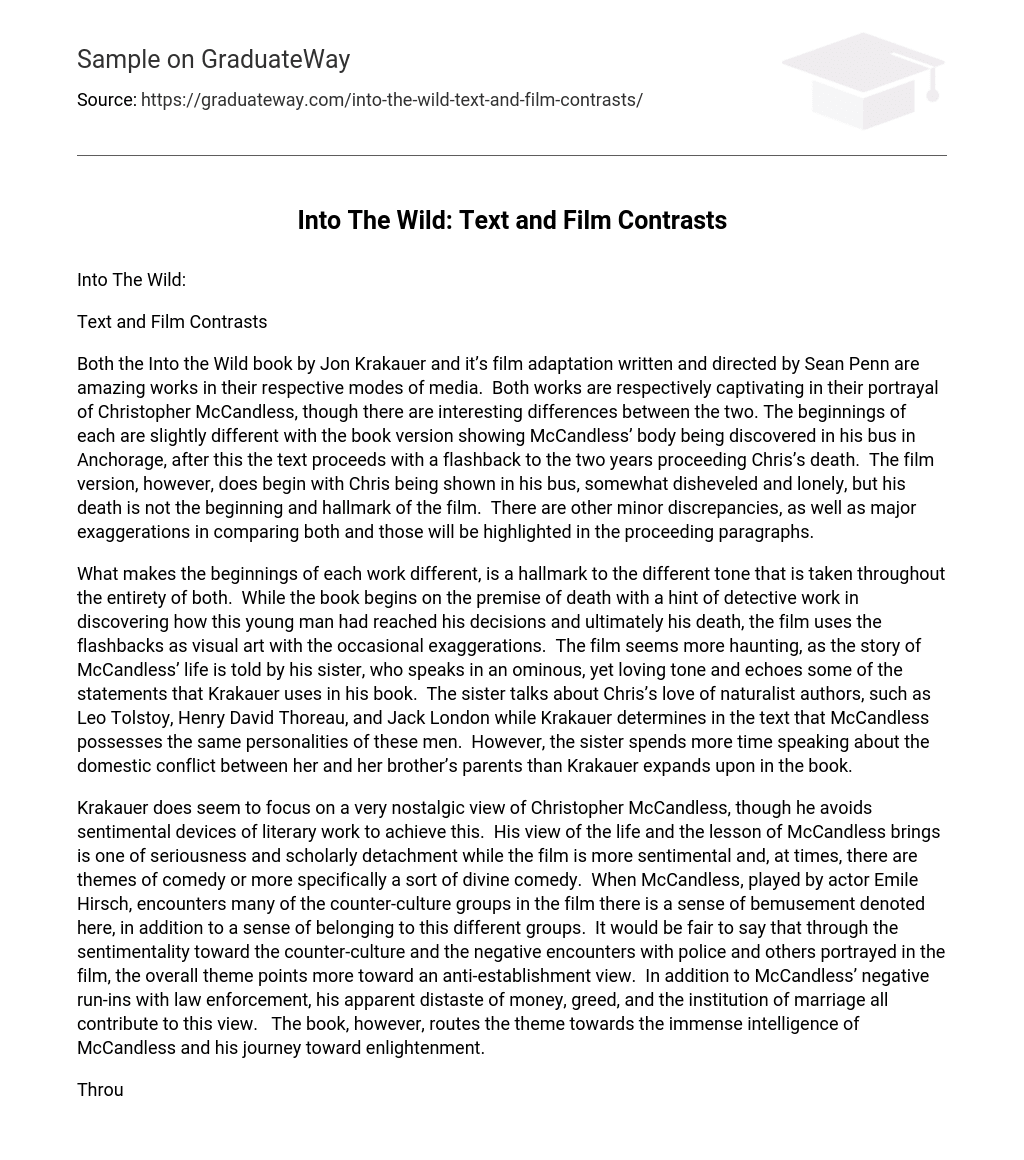Into The Wild:
Text and Film Contrasts
Both the Into the Wild book by Jon Krakauer and it’s film adaptation written and directed by Sean Penn are amazing works in their respective modes of media. Both works are respectively captivating in their portrayal of Christopher McCandless, though there are interesting differences between the two. The beginnings of each are slightly different with the book version showing McCandless’ body being discovered in his bus in Anchorage, after this the text proceeds with a flashback to the two years proceeding Chris’s death. The film version, however, does begin with Chris being shown in his bus, somewhat disheveled and lonely, but his death is not the beginning and hallmark of the film. There are other minor discrepancies, as well as major exaggerations in comparing both and those will be highlighted in the proceeding paragraphs.
What makes the beginnings of each work different, is a hallmark to the different tone that is taken throughout the entirety of both. While the book begins on the premise of death with a hint of detective work in discovering how this young man had reached his decisions and ultimately his death, the film uses the flashbacks as visual art with the occasional exaggerations. The film seems more haunting, as the story of McCandless’ life is told by his sister, who speaks in an ominous, yet loving tone and echoes some of the statements that Krakauer uses in his book. The sister talks about Chris’s love of naturalist authors, such as Leo Tolstoy, Henry David Thoreau, and Jack London while Krakauer determines in the text that McCandless possesses the same personalities of these men. However, the sister spends more time speaking about the domestic conflict between her and her brother’s parents than Krakauer expands upon in the book.
Krakauer does seem to focus on a very nostalgic view of Christopher McCandless, though he avoids sentimental devices of literary work to achieve this. His view of the life and the lesson of McCandless brings is one of seriousness and scholarly detachment while the film is more sentimental and, at times, there are themes of comedy or more specifically a sort of divine comedy. When McCandless, played by actor Emile Hirsch, encounters many of the counter-culture groups in the film there is a sense of bemusement denoted here, in addition to a sense of belonging to this different groups. It would be fair to say that through the sentimentality toward the counter-culture and the negative encounters with police and others portrayed in the film, the overall theme points more toward an anti-establishment view. In addition to McCandless’ negative run-ins with law enforcement, his apparent distaste of money, greed, and the institution of marriage all contribute to this view. The book, however, routes the theme towards the immense intelligence of McCandless and his journey toward enlightenment.
Through this journey of enlightenment in both forms of media, as stated before the text aims to avoid sentimental feelings and serves as a more research based work. The film possesses it’s own sentimentality, although it is in an artistic and beautiful form. With amazing visuals of the beauty of the American West coupled with music from the soundtrack, contributed by Eddie Vedder, who is known to be quite an anti-establishment personality, himself, this film is iconic and unforgettable. Though, to be fair, there are many film devices that cannot be employed in written work and this comparison does not diminish the quality of the text in any way.
One final difference and discrepancy is the method by which McCandless dies. In the text, it is offered that McCandless dies due to eating certain seeds that come from an edible potato, whereas the potato is harmless, the seeds contain a poison that can overcome a malnourished body. However, the film differs as it shows McCandless looking at his book that names all edible plants indigenous to Alaska and confusing a poisonous from a non-poisonous plant. In the film, this mistake causes his death. But, to be fair, both depictions attribute a plant issue as the contributing factor to his demise. The film, however, offers some hope to the non-reader of the book, that McCandless may survive his Alaskan adventure, where the book makes it clear that he has no chance, as he dies in the beginning.
In conclusion, both works of artistic depiction of the life and legacy of Christopher McCandless take slightly different approaches to the respective audience. While Krakauer attempts to convey the naturalistic personality of this character by providing references to London, Thoreau, and Tolstoy and focuses on the mechanisms of McCandless’ mind to understand why he became such an fixture in the area of American adventurers, Penn takes a different angle. Instead of attempting to dissect McCandless’ thinking, Penn is more concerned with society, subculture, and the art and wisdom of people, who chose to become like Chris. Krakauer seems to think and write as if McCandless is a very rare individual and it is true that his actions were extraordinary. Penn seems to paint a picture in this motion picture that shows that creativity and passion resides in everyone to varying degrees.
Works Cited
Jon Krakauer, Into the Wild, New York, NY: Anchor Books, 1997.
Sean Penn, Into the Wild, Paramount Vintage: Paramount Studio, Hollywood, CA, 2007.





